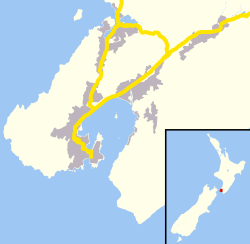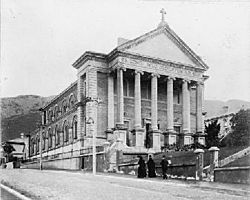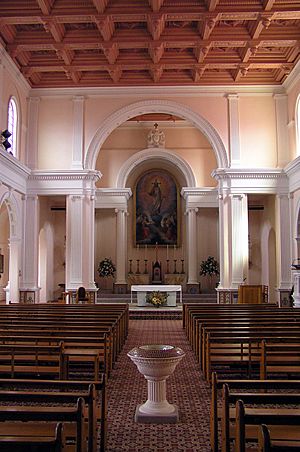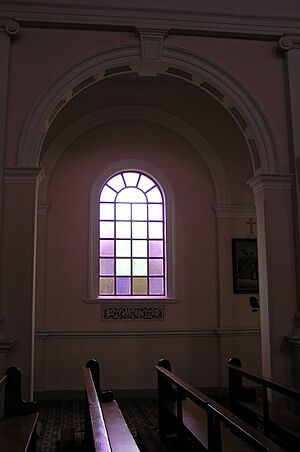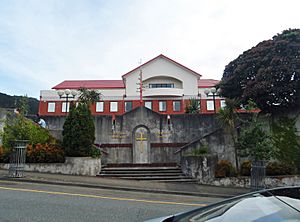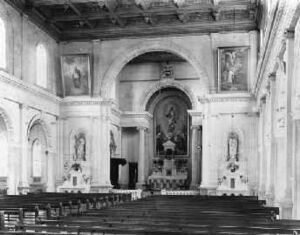Sacred Heart Cathedral, Wellington facts for kids
Quick facts for kids Sacred Heart Cathedral |
|
|---|---|
| Metropolitan Cathedral of the Sacred Heart and St Mary his Mother | |
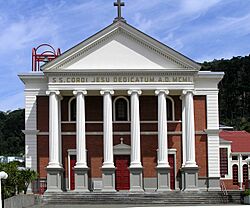
Wellington, Hill St
|
|
| 41°16′36″S 174°46′34″E / 41.2766°S 174.7762°E | |
| Location | Thorndon, Wellington Central City |
| Country | New Zealand |
| Denomination | Catholic |
| History | |
| Former name(s) | St Mary's Cathedral |
| Founded | 1851 |
| Founder(s) | Philippe Viard, 1st Bishop of Wellington (St Mary's Cathedral, 1851); Francis Redwood, 2nd Bishop and 1st Archbishop of Wellington (Sacred Heart Cathedral, 1901) |
| Dedication | 1901 124 years ago |
| Consecrated | 18 March 1984 |
| Architecture | |
| Heritage designation | Category I (2 April 1985) |
| Architect(s) | Francis Petre |
| Architectural type | Cathedral |
| Style | Palladian Revival |
| Completed | 1901 124 years ago |
| Specifications | |
| Materials | Oamaru stone |
| Administration | |
| Parish | Sacred Heart Cathedral Parish |
| Archdiocese | Wellington |
The Sacred Heart Cathedral is a major Catholic church in Wellington, New Zealand. It is the main church for the Thorndon Catholic community, which started in 1850. It is also where the Archbishop of Wellington has his special chair, called a cathedra. The cathedral is located right next to the New Zealand Parliament.
The church is part of a larger Catholic area. This area includes St Mary's College, Sacred Heart Cathedral School, and St Mary's Convent. The convent is the main house for the Sisters of Mercy in Wellington. There's also the Catholic Centre, where the church's administration is located, and Viard House. Viard House is both the home for the cathedral's priests and the Archbishop.
People often called the church "the Basilica" because of its grand, classical style of building. In 1984, it officially became the cathedral of Wellington. This happened after it was made stronger against earthquakes. New parts were also added, like a special chapel, a main entrance area, and a large open space called a piazza. For many years, priests from the Society of Mary looked after the Thorndon parish. In 2023, a Marist priest, Archbishop Paul Martin, became the new Archbishop.
The Archbishops of Wellington have almost always lived in Thorndon. The main cathedral building was closed in July 2018 for important repairs to make it safer from earthquakes. Services were held in the cathedral hall or another church during this time. The building reopened in June 2024.
Contents
Church Services
The church holds regular services, called Mass. Here are the usual times:
- Weekdays: 8:00 AM and 12:10 PM
- Saturday: 8:30 AM and 5:30 PM (this is an early Mass for Sunday)
- Sunday: 10:00 AM (with a choir) and 7:00 PM
Every year, around December 8th, a special Mass is held. This Mass renews a promise made in 1855 to protect Wellington from earthquakes.
Building History
The first church on this site was St Mary's Cathedral. It was made of wood and had a Gothic style. It opened in 1851 but was destroyed by fire in November 1898. After the fire, people decided to build a new, grander church on the same spot.
The foundation stone for the new church, called the Basilica of the Sacred Heart, was laid in 1899. It opened just two years later. Money meant for a completely new, larger cathedral was used to build this one instead. It was not until 1984 that this Basilica officially became the Sacred Heart Cathedral. On March 18, 1984, it was formally dedicated by Cardinal Thomas Williams. In 1985, the building was recognized as a very important historic place by Heritage New Zealand.

The cathedral is mostly built from Oamaru limestone with brick details. It was designed by architect Francis Petre. The building has a classical style, similar to ancient Roman or Greek temples. It has a grand entrance with large columns and a triangular top part. The Latin words on the front mean "Dedicated to the Sacred Heart of Jesus. A.D. 1901."
Inside, the church has a main walkway and two side walkways. There's a large main area with arches and a big arch leading to the altar area. The walls have stone pillars. In 1983, concrete pillars and steel beams were added to make the building stronger against earthquakes. The special chapel, entrance area, and a hall were added in 1984. A large open square was also built outside the main entrance. This area is used for gatherings and processions, especially during Easter. The cathedral once had two bell towers with domes, but these were removed in 1942 after an earthquake.
Special Features
Stone and Ceiling
The stone inside the cathedral used to be painted white, but it has been returned to its natural cream color. The ceiling is made of beautiful pressed metal with painted designs.
Main Altar
The main altar is made of marble. It has a three-part mosaic showing the Annunciation, which is when the Angel Gabriel told Mary she would have Jesus. The words on the altar mean "the word was made flesh." This altar was given to the cathedral in 2023.
Sacred Heart Art
Above the Archbishop's special chair, there is a large painting of the Sacred Heart of Jesus by Enrico Refto. At the top of the main arch, there is also a large stone symbol of the Sacred Heart.
Pulpit
The beautiful pulpit, where sermons are given, is still used today. It was put in place in 1908 to remember Father W. J. Lewis, who was the first priest of the new church and passed away in 1907. The names of all the bishops and archbishops of Wellington have recently been added to the pulpit's panels.
Bishop Viard Memorial
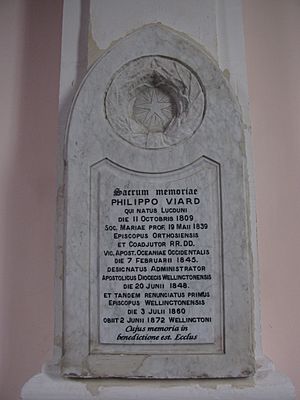
On a pillar near the South Aisle, there are three plaques that remember Philippe Viard, the first Bishop of Wellington. He passed away in 1872 and is buried in the cathedral. His tomb is near the baptismal font. Father Jean Baptist Petitjean, who came to Wellington with Bishop Viard, is also remembered here.
Blessed Sacrament Chapel
The Blessed Sacrament Chapel is a smaller chapel that can hold about 60 people. It has five beautiful stained-glass windows from England, made in 1885. These windows show abstract designs and saints like Patrick, John, Francis Xavier, and St Peter. The chapel also has a special icon of the Sacred Heart of Jesus and St Mary.
In the chapel's west wall, there is a small space where the holy oils are kept. This space is backed by a panel that used to be part of the altar in the old St Mary's Cathedral. The chapel was fully restored and reopened in December 2024.
Statue of Mary
In the courtyard next to the cathedral entrance, there is a two-meter tall, cast-iron statue of the Blessed Virgin Mary. This statue was made in France. It was placed high on the tower of the original St Mary's Cathedral in 1867. It faced the harbor and its gold color would shine in the morning sun. The statue was put there to remember the dedication of the diocese to the Immaculate Conception in 1855. This dedication was done to protect the city from earthquakes.
During the 1898 fire, the statue fell about 80 feet from the tower. Amazingly, it was found with only minor damage. Some people who saw it said it seemed to float down slowly and land upright without being harmed. In 1984, the statue, now painted white, was placed in the courtyard. It remains there as a symbol of Mary's protection over the city.
Other Art and Statues
Inside the cathedral entrance, there are small statues of the Four Evangelists. Near the altar area, there is a statue of St Brigid. Behind the Archbishop's chair, there is a special bronze cross that was made for the visit of Pope John Paul II in 1986. The altar area also has important mosaics. Below the Stations of the Cross, there are fourteen bronze sculptures called Mater Dolorosa. These show Mary's sadness as she watched Jesus' journey to the Cross. In 2023, a large statue of the Sacred Heart of Jesus was given to the cathedral and is now in the entrance area.
Māori Treasures (Taonga)
Among the special treasures (called taonga) of the cathedral are a 2-meter tall carved stone (a kohatu whakairo) inside the entrance and a carved wooden pole (a pou) in the piazza outside. These were gifts from Catholic Māori in the area and were put in place in 1989. They were carved by Lou Kereopa.
The carved stone has several layers of meaning. The base represents the strong foundation of faith from Jesus. Above that, panels show important parts of faith, like the seven sacraments, the Ten Commandments, and the Holy Trinity. Another panel shows the cathedral itself. The next layer shows four figures representing different stages of faith, from not believing to being a full Christian. These figures support the suffering world, over which the church brings Christ's light. This light is shown by a globe with a crown of thorns, representing human suffering and Jesus' sacrifice. The stone is topped with a church, symbolizing the hope the gospel offers. The cross on top represents all who follow Jesus.
Music and Choirs
Sacred Heart Cathedral has a strong tradition of music. There are groups that play instruments like piano, guitars, and organ, and sing to lead the congregation in hymns during Mass.
The cathedral used to have two traditional choirs. The main cathedral choir was made up of trained singers. They sang on most Sundays and at special events. They performed a wide range of music, from old Gregorian chants to modern pieces.
There was also a boys' choir, with about 15 boys from the nearby Sacred Heart Cathedral School. Each boy received a scholarship for singing lessons. They would sing at some Masses during the school term.
The main organ in the cathedral was built in 1905 and had been updated over the years. The cathedral was also a popular place for concerts because of its size and good sound quality.
When the cathedral closed for earthquake strengthening in 2018, the organ was removed for rebuilding in 2020. The choirs continued for a while in other places but stopped in March 2021. The plan is to review the music program once the cathedral is fully restored and all services return there.
Important Ceremonies
The cathedral choir played a big part in some important ceremonies.
When Sir Joseph Ward, who was the Prime Minister of New Zealand, passed away in July 1930, his funeral Mass was held at the Basilica. He had prayed there daily for 37 years. The Archbishop at the time, Archbishop Redwood, gave a speech. After the Mass, Sir Joseph Ward's casket stayed in the Basilica for people to pay their respects before being taken to Bluff for burial.
Michael Joseph Savage, the first Labour Prime Minister of New Zealand, passed away in March 1940. His funeral was broadcast across the country, giving the cathedral choir national recognition. The choir, made up of male voices and boys, sang the Mass. The church was so full that the boys had to sing from high up in the galleries. Archbishop O'Shea spoke about Savage's life, saying he was a good example for everyone. Savage's body was then taken by train to Auckland, with many mourners along the way.
Another big moment for the choir was in 1934, for the 60th anniversary of Archbishop Redwood becoming a bishop. The Basilica choir, with 50 voices, performed special music for the Mass.
See also
 In Spanish: Catedral del Sagrado Corazón (Wellington) para niños
In Spanish: Catedral del Sagrado Corazón (Wellington) para niños
- St Mary's Cathedral, Wellington
- Sacred Heart Cathedral School, Thorndon
- St Mary's College, Wellington
- Sisters of Mercy
- Roman Catholic Archdiocese of Wellington
- St Gerard's Church and Monastery
- St Joseph's Church, Mt Victoria
- St Mary of the Angels, Wellington
- Catholic Church in New Zealand


